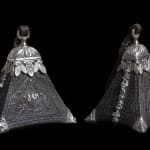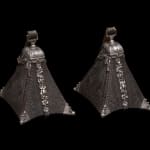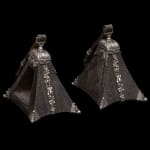PAIR OF BOX STIRRUPS
Unidentified artist, Peru, Early 19th century.
Initials of former owner: J. CH
Cast and chased silver, carved wood and leather.
25 x 26 x 17 cm
Further images
Provenance
Private collection.
The body of this pair of box stirrups is of a truncated pyramid shape with concave sides. The front and side faces present an ornate, symmetrical decoration including leaves, scrolls...
The body of this pair of box stirrups is of a truncated pyramid shape with concave sides. The front and side faces present an ornate, symmetrical decoration including leaves, scrolls and geometric elements, while at the back there is the gap necessary to house the foot, with a strap of repoussé leather at the bottom. The corners are reinforced with plain protective silver caps, which boast the particular feature of relief leaves culminating in typical little Andean cherub heads. Silver bands like garlands run along the middle of the sides, decorated with floral and foliate motifs. On the sides we find typical symmetrical and geometric carvings including volutes and spiraling and cruciform motifs. In the middle of the front we can observe a triangle inside of which there is a geometric decoration taking the form of flowers, ornate trimming, crosses and braided cords. To the sides, we find symmetrical ornamental borders containing circular motifs, spiraling and cruciform elements around the central feature.
At the top, a piece of chased silver is mounted on the crown of the pyramid, serving to secure the thick cast silver hook-eye. This silver cap is decorated with superimposed floral and foliate motifs, executed in relief and topped by curved forms with leaves, flowers and scrolls in low relief. The eye, which is plain and rectangular, gives the impression that it is being held aloft by a hand, and is attached to the finely braided leather saddle strap.
The origin of the stirrups is China as we known it today, towards the 4th century. Its function is to stop the weight of the human body from being concentrated on one single area, and it must have been developed by some nomadic peoples, given that distributing body weight over three areas made it easier to undertake long journeys. The device was adopted in the West during the middle ages, and it gradually evolved over the passing centuries, with the use of metal being the most important factor in its manufacture. Thanks to the stirrup, riders had their arms free, which was of fundamental importance for military campaigns and expeditions, as well as for rural work. The manufacture of stirrups steadily adapted to the varying requirements, aimed at the comfort and safety of the rider, and tailored to variations in climate and terrain.
The pair of stirrups we have before us here, being of the carved wood box stirrup variety, have the characteristic of protecting the rider from geographic conditions, in places where there were spiky bushes, torrential rivers and inclement climates. The Jesuits’ arrival in the Americas, and the great number of artisans that came with them, contributed to the development of varying trades. They brought with them the necessary knowledge, materials and tools to undertake this sort of carving work in objects belonging to the rural world. It is as such that ornamental motifs such as rosettes, volutes, decorative borders, phytomorphic devices, spirals, buds, braided cords,geometric patterns and adornments could come to be so widely developed in the artistic silverware of the Viceroyalty of Peru.
Box stirrups are generally made out of a single piece of hollowed-out wood, the inside of which is given a concave form in order to allow for the introduction of the foot. Another integral element is the rim, a metal band that goes around the sides of the stirrup like a belt, and which serves as a support to secure the eye at the top, which the straps that are attached to the saddle go through. Box stirrups evolved from a rural context to the sophisticated and refined world of riders51 who enjoyed the elegant and fine walking gait of the Peruvian Paso horse, becoming highly-valued artistic items, as is the case for our exceptional pair of stirrups.
4
of
4







